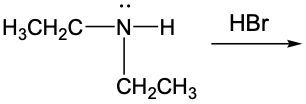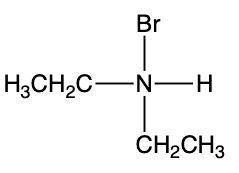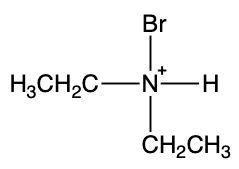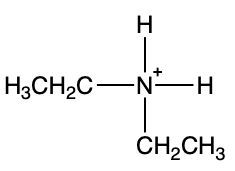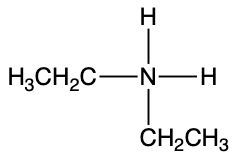This video, we're going to take a look at amine reactions through the prism of acid-base reactions. Now under this type of reaction, an acid reacts with an amine, which represents a weak base. Now recall, when a base accepts an H+, it transforms into a conjugate acid. This conjugate acid of an amine is called the Ammonium ion. Now, here we're going to say for the Ammonium ion, we modify the ending of amine, which is the neutral form of our amine, to ammonium ion. So if we take a look here at this generic amine reaction, we have Methylamine as our starting amine, it's reacting with hydrochloric acid which is an acid. We know following the Brønsted definition that the acid donates an H+ to the base. So when it accepts that H+, it's now accepting an H+, so now nitrogen is making 4 bonds, so it's going to be positively charged. And we're going to say when a nitrogen is positively charged by making 4 bonds, that's when the moniker of Ammonium ion comes into play. So we're going from methylamine to methyl ammonium ion. Okay, so this would be the name of our newly created ammonium ion product.
- 1. Matter and Measurements4h 29m
- What is Chemistry?5m
- The Scientific Method9m
- Classification of Matter16m
- States of Matter8m
- Physical & Chemical Changes19m
- Chemical Properties8m
- Physical Properties5m
- Intensive vs. Extensive Properties13m
- Temperature (Simplified)9m
- Scientific Notation13m
- SI Units (Simplified)5m
- Metric Prefixes24m
- Significant Figures (Simplified)11m
- Significant Figures: Precision in Measurements7m
- Significant Figures: In Calculations19m
- Conversion Factors (Simplified)15m
- Dimensional Analysis22m
- Density12m
- Specific Gravity9m
- Density of Geometric Objects19m
- Density of Non-Geometric Objects9m
- 2. Atoms and the Periodic Table5h 23m
- The Atom (Simplified)9m
- Subatomic Particles (Simplified)12m
- Isotopes17m
- Ions (Simplified)22m
- Atomic Mass (Simplified)17m
- Atomic Mass (Conceptual)12m
- Periodic Table: Element Symbols6m
- Periodic Table: Classifications11m
- Periodic Table: Group Names8m
- Periodic Table: Representative Elements & Transition Metals7m
- Periodic Table: Elemental Forms (Simplified)6m
- Periodic Table: Phases (Simplified)8m
- Law of Definite Proportions9m
- Atomic Theory9m
- Rutherford Gold Foil Experiment9m
- Wavelength and Frequency (Simplified)5m
- Electromagnetic Spectrum (Simplified)11m
- Bohr Model (Simplified)9m
- Emission Spectrum (Simplified)3m
- Electronic Structure4m
- Electronic Structure: Shells5m
- Electronic Structure: Subshells4m
- Electronic Structure: Orbitals11m
- Electronic Structure: Electron Spin3m
- Electronic Structure: Number of Electrons4m
- The Electron Configuration (Simplified)22m
- Electron Arrangements5m
- The Electron Configuration: Condensed4m
- The Electron Configuration: Exceptions (Simplified)12m
- Ions and the Octet Rule9m
- Ions and the Octet Rule (Simplified)8m
- Valence Electrons of Elements (Simplified)5m
- Lewis Dot Symbols (Simplified)7m
- Periodic Trend: Metallic Character4m
- Periodic Trend: Atomic Radius (Simplified)7m
- 3. Ionic Compounds2h 18m
- Periodic Table: Main Group Element Charges12m
- Periodic Table: Transition Metal Charges6m
- Periodic Trend: Ionic Radius (Simplified)5m
- Periodic Trend: Ranking Ionic Radii8m
- Periodic Trend: Ionization Energy (Simplified)9m
- Periodic Trend: Electron Affinity (Simplified)8m
- Ionic Bonding6m
- Naming Monoatomic Cations6m
- Naming Monoatomic Anions5m
- Polyatomic Ions25m
- Naming Ionic Compounds11m
- Writing Formula Units of Ionic Compounds7m
- Naming Ionic Hydrates6m
- Naming Acids18m
- 4. Molecular Compounds2h 18m
- Covalent Bonds6m
- Naming Binary Molecular Compounds6m
- Molecular Models4m
- Bonding Preferences6m
- Lewis Dot Structures: Neutral Compounds (Simplified)8m
- Multiple Bonds4m
- Multiple Bonds (Simplified)6m
- Lewis Dot Structures: Multiple Bonds10m
- Lewis Dot Structures: Ions (Simplified)8m
- Lewis Dot Structures: Exceptions (Simplified)12m
- Resonance Structures (Simplified)5m
- Valence Shell Electron Pair Repulsion Theory (Simplified)4m
- Electron Geometry (Simplified)8m
- Molecular Geometry (Simplified)11m
- Bond Angles (Simplified)11m
- Dipole Moment (Simplified)15m
- Molecular Polarity (Simplified)7m
- 5. Classification & Balancing of Chemical Reactions3h 17m
- Chemical Reaction: Chemical Change5m
- Law of Conservation of Mass5m
- Balancing Chemical Equations (Simplified)13m
- Solubility Rules16m
- Molecular Equations18m
- Types of Chemical Reactions12m
- Complete Ionic Equations18m
- Calculate Oxidation Numbers15m
- Redox Reactions17m
- Spontaneous Redox Reactions8m
- Balancing Redox Reactions: Acidic Solutions17m
- Balancing Redox Reactions: Basic Solutions17m
- Balancing Redox Reactions (Simplified)13m
- Galvanic Cell (Simplified)16m
- 6. Chemical Reactions & Quantities2h 35m
- 7. Energy, Rate and Equilibrium3h 46m
- Nature of Energy6m
- First Law of Thermodynamics7m
- Endothermic & Exothermic Reactions7m
- Bond Energy14m
- Thermochemical Equations12m
- Heat Capacity19m
- Thermal Equilibrium (Simplified)8m
- Hess's Law23m
- Rate of Reaction11m
- Energy Diagrams12m
- Chemical Equilibrium7m
- The Equilibrium Constant14m
- Le Chatelier's Principle23m
- Solubility Product Constant (Ksp)17m
- Spontaneous Reaction10m
- Entropy (Simplified)9m
- Gibbs Free Energy (Simplified)18m
- 8. Gases, Liquids and Solids3h 25m
- Pressure Units6m
- Kinetic Molecular Theory14m
- The Ideal Gas Law18m
- The Ideal Gas Law Derivations13m
- The Ideal Gas Law Applications6m
- Chemistry Gas Laws16m
- Chemistry Gas Laws: Combined Gas Law12m
- Standard Temperature and Pressure14m
- Dalton's Law: Partial Pressure (Simplified)13m
- Gas Stoichiometry18m
- Intermolecular Forces (Simplified)19m
- Intermolecular Forces and Physical Properties11m
- Atomic, Ionic and Molecular Solids10m
- Heating and Cooling Curves30m
- 9. Solutions4h 10m
- Solutions6m
- Solubility and Intermolecular Forces18m
- Solutions: Mass Percent6m
- Percent Concentrations10m
- Molarity18m
- Osmolarity15m
- Parts per Million (ppm)13m
- Solubility: Temperature Effect8m
- Intro to Henry's Law4m
- Henry's Law Calculations12m
- Dilutions12m
- Solution Stoichiometry14m
- Electrolytes (Simplified)13m
- Equivalents11m
- Molality15m
- The Colligative Properties15m
- Boiling Point Elevation16m
- Freezing Point Depression9m
- Osmosis16m
- Osmotic Pressure9m
- 10. Acids and Bases3h 29m
- Acid-Base Introduction11m
- Arrhenius Acid and Base6m
- Bronsted Lowry Acid and Base18m
- Acid and Base Strength17m
- Ka and Kb12m
- The pH Scale19m
- Auto-Ionization9m
- pH of Strong Acids and Bases9m
- Acid-Base Equivalents14m
- Acid-Base Reactions7m
- Gas Evolution Equations (Simplified)6m
- Ionic Salts (Simplified)23m
- Buffers25m
- Henderson-Hasselbalch Equation16m
- Strong Acid Strong Base Titrations (Simplified)10m
- 11. Nuclear Chemistry56m
- BONUS: Lab Techniques and Procedures1h 38m
- BONUS: Mathematical Operations and Functions47m
- 12. Introduction to Organic Chemistry1h 34m
- 13. Alkenes, Alkynes, and Aromatic Compounds2h 12m
- 14. Compounds with Oxygen or Sulfur1h 6m
- 15. Aldehydes and Ketones1h 1m
- 16. Carboxylic Acids and Their Derivatives1h 11m
- 17. Amines38m
- 18. Amino Acids and Proteins1h 51m
- 19. Enzymes1h 37m
- 20. Carbohydrates1h 46m
- Intro to Carbohydrates4m
- Classification of Carbohydrates4m
- Fischer Projections4m
- Enantiomers vs Diastereomers8m
- D vs L Enantiomers8m
- Cyclic Hemiacetals8m
- Intro to Haworth Projections4m
- Cyclic Structures of Monosaccharides11m
- Mutarotation4m
- Reduction of Monosaccharides10m
- Oxidation of Monosaccharides7m
- Glycosidic Linkage14m
- Disaccharides7m
- Polysaccharides7m
- 21. The Generation of Biochemical Energy2h 8m
- 22. Carbohydrate Metabolism2h 22m
- 23. Lipids2h 26m
- Intro to Lipids6m
- Fatty Acids25m
- Physical Properties of Fatty Acids6m
- Waxes4m
- Triacylglycerols12m
- Triacylglycerol Reactions: Hydrogenation8m
- Triacylglycerol Reactions: Hydrolysis13m
- Triacylglycerol Reactions: Oxidation7m
- Glycerophospholipids15m
- Sphingomyelins13m
- Steroids15m
- Cell Membranes7m
- Membrane Transport10m
- 24. Lipid Metabolism1h 45m
- 25. Protein and Amino Acid Metabolism1h 37m
- 26. Nucleic Acids and Protein Synthesis2h 54m
- Intro to Nucleic Acids4m
- Nitrogenous Bases16m
- Nucleoside and Nucleotide Formation9m
- Naming Nucleosides and Nucleotides13m
- Phosphodiester Bond Formation7m
- Primary Structure of Nucleic Acids11m
- Base Pairing10m
- DNA Double Helix6m
- Intro to DNA Replication20m
- Steps of DNA Replication11m
- Types of RNA10m
- Overview of Protein Synthesis4m
- Transcription: mRNA Synthesis9m
- Processing of pre-mRNA5m
- The Genetic Code6m
- Introduction to Translation7m
- Translation: Protein Synthesis18m
Amine Reactions - Online Tutor, Practice Problems & Exam Prep
 Created using AI
Created using AIIn acid-base reactions, amines act as weak bases, accepting protons (H+) from acids, resulting in the formation of ammonium ions. For example, methylamine reacts with hydrochloric acid, transforming into methylammonium ion. This process illustrates the Brønsted-Lowry definition, where the acid donates a proton, and the amine becomes positively charged by forming four bonds with nitrogen. Understanding these transformations is crucial for grasping the behavior of amines in various chemical contexts.
Acid-Base Reaction Concept 1
Video transcript
Acid-Base Reaction Example 1
Video transcript
Predict the products formed from the following reaction between nitric acid and ammonia. Right. So nitric acid is our acid, ammonia is our neutral amine, so it's a weak base. Here, we're using the Bronsted-Lowry definition. We know that the acid donates an H+. So when that acid donates an H+, it forms a conjugate base, so it's going to form the nitrate ion, and then ammonia gains an H+ to become NH4+, so it becomes the ammonium ion. In addition to this, notice that there is a solid arrow going forward because we have a strong species mixing with a weak species. Nitric acid is a strong acid, mixing with ammonia which is a weak base. When a strong species, acid or base is involved, we have complete formation of our products, so we have a solid arrow going forward. Okay? But in this particular example here, we're going to say our Nitrate ion and Ammonium ions are our products created between the reaction of nitric acid and ammonia.
Determine the ammonium ion formed in the following reaction between diethylamine and hydrobromic acid.
Do you want more practice?
Here’s what students ask on this topic:
What is the role of amines in acid-base reactions?
Amines act as weak bases in acid-base reactions. They accept protons (H+) from acids, resulting in the formation of ammonium ions. For example, when methylamine (CH3NH2) reacts with hydrochloric acid (HCl), it accepts a proton to form methylammonium ion (CH3NH3+). This process follows the Brønsted-Lowry definition, where the acid donates a proton, and the amine becomes positively charged by forming four bonds with nitrogen. Understanding this behavior is crucial for grasping the chemical properties and reactions of amines.
 Created using AI
Created using AIHow does methylamine react with hydrochloric acid?
Methylamine (CH3NH2) reacts with hydrochloric acid (HCl) in an acid-base reaction. The hydrochloric acid donates a proton (H+) to the methylamine, which acts as a weak base. This results in the formation of methylammonium ion (CH3NH3+) and chloride ion (Cl-). The reaction can be represented as:
 Created using AI
Created using AIWhat is an ammonium ion and how is it formed?
An ammonium ion is a positively charged ion (NH4+) formed when an amine accepts a proton (H+) from an acid. In the context of methylamine (CH3NH2), when it reacts with hydrochloric acid (HCl), it accepts a proton to form the methylammonium ion (CH3NH3+). This process involves the nitrogen atom in the amine forming four bonds, resulting in a positive charge. The general reaction can be represented as:
 Created using AI
Created using AIWhy do amines form ammonium ions when reacting with acids?
Amines form ammonium ions when reacting with acids because they act as bases, accepting protons (H+) from the acids. This protonation increases the number of bonds nitrogen forms, resulting in a positively charged ammonium ion. For instance, when methylamine (CH3NH2) reacts with hydrochloric acid (HCl), it accepts a proton to form methylammonium ion (CH3NH3+). This transformation is essential for understanding the behavior of amines in various chemical reactions and contexts.
 Created using AI
Created using AIWhat is the Brønsted-Lowry definition of acids and bases?
The Brønsted-Lowry definition of acids and bases describes acids as proton donors and bases as proton acceptors. In this framework, an acid donates a proton (H+) to a base. For example, in the reaction between hydrochloric acid (HCl) and methylamine (CH3NH2), HCl donates a proton to CH3NH2, forming the methylammonium ion (CH3NH3+) and chloride ion (Cl-). This definition helps in understanding the behavior of substances in acid-base reactions.
 Created using AI
Created using AIYour GOB Chemistry tutor
- Complete the following equations: c. <IMAGE>
- Complete the following equations: a. <IMAGE>
- Write an equation for the acid-base equilibrium of:a.Pyrrolidine and waterLabel each species in the equilibriu...
- Explain what bonds must be made or broken and where the electrons go when the hydrogen-bonded water between th...
- Complete the following equations: b. <IMAGE>
- Draw the structures of the ammonium ions formed when the amines in Problem 16.30 are treated with acid.
- Complete the following equations (hint: remember that a nitrogen with three groups bound to it has a lone pair...
- Complete the following equations. (Hint: Remember that a nitrogen with three groups bound to it has a lone pai...
- Choline has the following structure. Do you think that this substance reacts with aqueous hydrochloric acid? I...
- Complete the following equations (Hint: Answers may include concepts learned from previous organic chapters):a...
- Complete the following equations (Hint: Answers may include concepts learned from previous organic chapters):c...
- Complete the following equations (Hint: Answers may include concepts learned from previous organic chapters):e...
- Arrange the following compounds in order of increasing boiling point. Explain why you placed them in that orde...
- The structure of the amino acid lysine (in its uncharged form) is shown below. <IMAGE>b. Is lysine likel...
- Write the balanced chemical equations for the (1) reaction of each of the following amines with water and (2) ...
- Indicate if each of the following is soluble in water. Explain. ...
- Indicate if each of the following is soluble in water. Explain. ...
- Write the balanced chemical equations for the (1) reaction of each of the following amines with water and (2) ...
- Write the balanced chemical equations for the (1) reaction of each of the following amines with water and (2) ...
- Indicate if each of the following is soluble in water. Explain. ...
- Indicate if each of the following is soluble in water. Explain. ...
- Draw the condensed structural or line-angle formulas for the products of the following: (14.5)a. CH₃―CH₂―NH₂ ...
